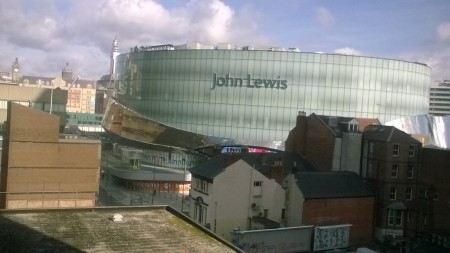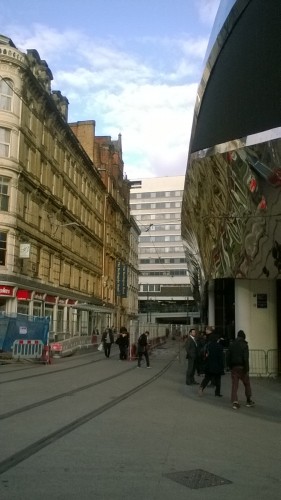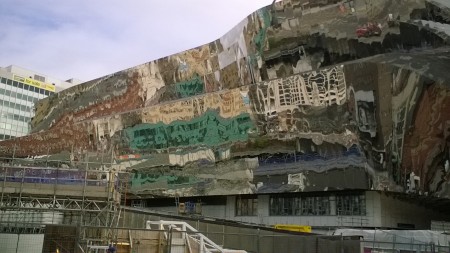Birmingham New Street: the attentional commons colonized by commerce
It so happened that while I was reading about a concept of the “attentional commons,” I was staying right next door to a building that perfectly illustrated the problem that Matthew Crawford talks about in The World Beyond Your Head, as I’m going to explain below. But first, let’s take a few moments to deal with New Street Station.
I cannot think of an uglier, more monstrous, pretentious and dehumanizing building in contemporary Britain than Birmingham New Street Station. Not that you’d even know it was there at all now, because it’s been smothered by a gigantic steel tablecloth with all signs of movement, travel, public service, usefulness and even the name of the station itself hidden from view. Being inside it is no better: you cannot use your own judgement and vision to see where the trains are, or any local landmarks to get your bearings. I know roughly where the town hall, the cathedral, the Bull Ring, and the Hippodrome are, and I used to know where the station was, but inside Grand Central (as the place—whatever it is—is called now) there is no geography, no public space, no lines, no corners, no light and shade. It’s like being imprisoned in a light bulb.

The Station Street entrance to New Street Station/Grand Central, with its permanent TV screen of advertisements: abuse of the attentional commons
The people I pity most are those who live in Station Street, whose buildings are bathed 24 hours a day in the changing coloured lights of the enormous advertising “eye” over the front entrance of the building, where in the past, a moderately sized and lit sign with the name of the station and a British Rail logo should have been. The eye is the biggest insult of all. Whereas human eyes move in order to take in aspects of the environment, this massive advertising screen fixes your stare, and is too big to be avoided by any regular eye movement. High above it, John Lewis’s glass and steel gasometer dominates and obliterates the skyline.Everything of human proportions and everyday use is dwarfed and humiliated in its sight. It’s a kind of Stalinist monumentalism adopted by a department store, except I think a Stalinist would at least have built a park or something to give the building and the public some breathing space.

Never Knowingly Undersized, John Lewis’s grandiose, vacuous gasometer hiding the wonderful civic architecture behind it.
Giving distraction a name: the assault on the attentional commons
I could not give a name to the visceral annoyance that Grand Central induces in me every time I see it, until I read Matthew Crawford’s The World Beyond Your Head: How to Flourish in An Age of Distraction, where he uses the term attentional commons. He begins by emphasising that human attention is a limited resource, continually at risk of depletion by the advertising that increasingly occupies every spare bit of space around us (on the side of buses, tickets, hotel key fobs, on televisions in departure lounges and post offices, for example). Our attentional resources, and the “attentional commons” are being plundered by private advertisers.
Airports are probably the worst example. Just once in my life, I was in the business class lounge at an airport, and experienced exactly what Crawford describes: what you get for travelling business class is the absence of advertising, and the freeing up of your attention for your own stuff. It’s what we used to expect of the outside world as a normal condition, but no longer: in one example cited by Crawford, adverts for l’Oréal in the bottom of the security trays at airports compete for your attention, so that you might easily miss the USB drive that you put in there.
I’ve got another example that involves humans. I have only twice in my life left my debit card in a machine at a shop, and in both cases, it was because at the crucial point where I needed to focus on putting in my PIN and removing the card, the shop assistant started asking me whether I wanted the chance to enter a free prize draw, or get a two-for-one offer instead of the thing that I had bought. In both cases, I was just about to leave the country on a trip, so my attention was already used up on all the other things I needed to do. This is a claim on my attention, with disastrous consequences, and it’s at a point where I think the shop has an ethical obligation to observe what Crawford calls my right not to be addressed. If you’re driving a car, and your passenger can see you’re negotiating a difficult situation on the road, they’ll shut up and let you concentrate. We have an ethical responsibility to be respectful of the limited attentional resources of others—and it’s that responsibility that is increasingly ignored in public life.
The right not to be addressed
Crawford’s point is that we take it for granted that we have a right not to be addressed in this way, but this right is being eroded in the form of advertising and noise (there’s an interesting parallel here with what Bart Kosko says in Noise about things like email spam, which constitute intrusive, unethical “noise”).
I think we need to sharpen the conceptually murky right to privacy by supplementing it with a right not to be addressed. This would apply not, of course, to those who address me face-to-face as individuals, but to those who never show their face, and treat my mind as a resource to be harvested by mechanized means. (p. 13)

And that’s what is so vile about Grand Central. Its enormous tent-like shape hides the station beneath it, and overwhelms and obscures the public space all around it. And as if that weren’t enough it has a permanent TV show of adverts on its eye-shaped screen, commanding and appropriating attention. Inside, everything about travel, trains, stations and information is dwarfed by the shopping centre. It’s the kind of station brilliantly described in a novel I can’t remember the name of where platforms and trains are an embarrassment that the architects have tried to hide away. “Grand Central” is also another example of the insidious privatisation of public space, it’s oversized, inhuman proportions thrust up against the surrounding landscape with the lack of grace of an overweight giant taking over the seat next to you on a plane. It isn’t even elegant: the steel canopy gives up a few feet above the street, as if the designer couldn’t work out how to finish it off. If a builder did this to your house, you’d sue them.
Corporate manspreading
It’s manspreading on a massive corporate scale, but we barely have a name for the rights that are eroded when so much public space is intruded by adverts and demands on your attention. Now we do. It’s a concept of an attentional commons, and the right not to be addressed. I’m not sure what we can do about it, but I hope at least that the residents of Station Street are going to give Grand Central hell until they turn that bloody TV screen off.

Update: the building that says “f**k context”
Many years since I first wrote this post, I discovered an essay by architect Rem Koolhaas that much more succinctly expressed what had eaten away at me so much. In Bigness, or the problem of large, drawing on a theory of “bigness” in architecture from his earlier book Delirious New York, Koolhaas says
all these breaks—with scale, with architectural composition, with tradition, with transparency, with ethics—imply the final, most radical break: BIGNESS is no longer part of any tissue. It exists; at most, it coexists. Its subtext is fuck context.
Koolhaas, Bigness, or the problem of large (1995)
That’s it. That’s exactly what that building says to me.
Update: The new “Poo emoji” W Hotel in Edinburgh
08th July 2021: Having spent a few years wondering if it’s just me that gets irked by this kind of thing, I was pleased to see The Guardian has an article about the new W Hotel in Edinburgh: “‘A great city has been defaced’: why has a poo emoji arrived on Edinburgh’s skyline? This is not only a case of a building f**king context, it’s shitting on it as well. From the photographs in the article, the shopping centre reminds me of the Palladium mall in Prague, one of the deadest, saddest and most pointless places in that beautiful city.
More about attentional commons and distraction
- For an explanation and defence of the concept of “the commons,” see Antonia Malchik’s article on Aeon, “Who owns the earth?“
- The author Will Self is concerned about the related issue of the privatisation of public space: see this article in the Guardian from 13th February 2016 (“Author warns of ‘threat to national psyche’ as campaigners rally outside City Hall to protest at corporate takeover of streets and squares”)
- “Distraction is a kind of obesity of the mind” — Interview and samples from Matthew Crawford’s book

